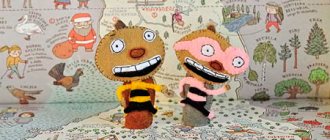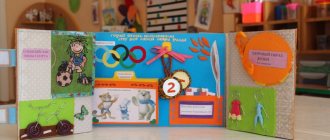Every person's speech consists of sounds. The child’s development depends on how correctly the letters are pronounced. If a child under 5–6 years old makes mistakes in reproducing phonemes, you should seek help from a specialist.
Recently, incorrect pronunciation of the letter D has become increasingly common among children. To eliminate the defect, the sounds “D” and “D” should be produced and automated.
Types of deviations
Characteristics of pronunciation defects:
Consonant voiced
Stun.
the sound “D” at different positions in words turns into
steam room
deaf
I agree
"T". The disorder occurs due to the similarity in the location of the articulatory apparatus during reproduction, poor development of phonemic perception and organic deficiencies of the speech organs. The defect is eliminated again using the phoneme “B”.- Open twang. Replacing the sound
“D” with “N”. The sky curtain is down. The tip of the tongue does not push away from the incisors. There is no push of the air stream from the oral cavity. The air leaves the nasal cavity in a continuous manner. - Clicking "D". Correction is carried out by regulating breathing during pronunciation.
You can check correct reproduction in the form of a small test, suitable for older
groups
of preschoolers
:
- An adult pronounces sentences with frequent letter repetition. For example, Dina blows a trumpet. The child is asked to repeat what he heard.
- Using illustrations of objects with the sounds “D” and “D”. Place the pictures
in front of the child. Ask to name what is depicted on them (oak, house, melon, children, hollow, etc.) - Search for the desired picture. The adult says the name of one depicted object among the presented pictures, and the child finds it and names it.
Such simple tasks are used in preparatory groups
to identify defects in sound pronunciation and to develop the thinking abilities of children. Similar activities are used for all types of phonemes.
Causes of pronunciation problems
The occurrence of incorrect reproduction of soft and hard
"D" is accompanied by:
- lack of correct articulation
of the speech organs; - underdevelopment of phonemic hearing (the child does not distinguish sounds from each other);
- repeating the mistakes of others;
- weak motor activity of the lower jaw and other organs of the speech apparatus (occurs with dysarthria).
Note: dysarthria is a violation of the innervation of the speech organs. The deviation appears due to damage to the central nervous system.
It is possible to establish an accurate diagnosis and cause after speech therapy
examinations.
After collecting a detailed history, the speech therapist
prescribes corrective
tasks
. Some classes should be done at home.
Supporting measures
Often with dysarthria there is an increased or decreased tone of the speech organs. In order to cope with this problem, speech therapy massage is used.
It can be either manual or probe. The procedure consists of stroking and light pressure on different areas. This is often done at the beginning of each lesson. This makes the muscles susceptible to the effects.
Dysarthria is often accompanied by increased salivation. To reduce secretion, give jelly, chew biscuits and crackers. Before the lesson, the child is seated on a chair, asked to throw back his head and imitate chewing. The speech therapist can massage the points behind the ears and the junction of the jaws. This will reduce the work of the glands.
There are no uniform patterns when producing sounds. For each child, methods are selected individually.
Correct articulation for the sounds D and D
When playing the sound “D” the speech apparatus takes the position:
The lips are completely neutral. The production depends on the subsequent vowel phoneme. The distance between the lips and incisors is about 5 mm.- The tip of the tongue rests on the upper jaw. May touch the alveoli behind the upper teeth.
- The soft part of the palate descends.
- The larynx vibrates.
- The vocal folds are closed. Presence of voiceover.
The articulation of the soft “D” differs from the hard one only in the position of the tongue. Its tip falls behind the lower incisors.
Important: Classes aimed at establishing phonemes should be conducted after the child has mastered simple vowels and consonants (a, y, o, i, e, s) and (b b, p p, mm, v v, f f).
Set the sound [C]
The articulation is as follows:
- lips are in a neutral position;
- teeth are brought closer by 1-2 mm;
- the tip of the tongue is lowered, touching the lower incisors; Initially, the back of the tongue is strongly curved, forming a bow with the incisors, then its front part quickly moves to the position of the “C” sound, forming a groove in the middle;
- the air stream should be strong and uneven.
The sound “C” is produced if the child clearly pronounces the sounds “S” and “T”. The baby is asked to quickly pronounce “TS”, as a result of which the desired sound appears.
There are 3 ways to make the sound “C”:
- Method of imitation using play techniques (“The locomotive, stopping, says - tss-ts-ts”, “The mouse is sleeping, don’t make noise - tss-ts-ts!”).
- Reception of reference sounds (in this case these are “T” and “S”).
- Acceptance of the features of articulatory structure. Invite the child to open his mouth, rest the tip of his tongue against the incisors of the lower row of teeth, lift the tongue and stretch it so that its front part is pressed against the palate. In this position, the back of the tongue should touch the upper incisors. Without turning on your voice, invite your baby to pronounce the sound “T”, lifting the tip of the tongue with the pressure of a stream of air from the front teeth of the lower row. The lips should be tense and in a smiling position. This exercise helps to remember the position of the organs of articulation when the sound “C” is pronounced.
Exercises for staging
Before you begin to master the phoneme, you should go through the preparatory stage. It consists of performing special articulation and breathing exercises (here). The child must be taught correct articulation (position of the speech organs) and breathing during the pronunciation of an isolated sound.
Articulation gymnastics
The classes are designed to train the organs involved in the pronunciation of the sounds “D” and “D” description
:
- Lower jaw. Open your mouth wide. Use your lower jaw to imitate chewing movements. Perform for 10-15 seconds.
- Lips and cheeks:
- lips are closed, and air should be drawn into the oral cavity. Next, imitate rinsing as after brushing your teeth in the morning;
- use your lips to make characteristic sounds for a horse (snorting);
- pouting lips in turn. First the top, then the bottom.
3. Language:
Exercise "Mushroom"
- "Fungus". Smile widely with your mouth open. The flat tongue is sucked to the palate. In this case, the organ should be located behind the upper incisors. Hold the position for 10-15 seconds.
- "Horse". Click your tongue on the hard palate, imitating the sound of a horse's hooves.
- "Swing". Open your mouth wide, slightly exposing your teeth. Place the tongue behind the upper and lower teeth in turn. Performed 5 times.
4.Soft palate. The baby is asked to reproduce vowel sounds. The pronunciation is soft at first, and then a hard attack is applied.
Advice: to prevent your baby from getting bored with doing the same exercises, you can use classes prescribed for speech therapists. Many options are available on the Internet.
Breathing exercises
Experts suggest performing paradoxical gymnastics according to Strelnikova. But its use is allowed for children 7-8 years old ( grade 1
). Exercises should be performed under the supervision of parents or a specialist. Initial exercises:
- Palms. The child stands up straight. He bends his arms at the elbows and shows his palms to the adult. Hands clench into fists as you inhale and unclench as you exhale. You need to breathe through your nose. Perform the exercise 4 times.
- Shoulder straps. The baby is standing upright. Hands clenched into fists. They are pressed to the belt. While inhaling, hit the floor with your fists. Gradually unclenching your hands. As you exhale, return to the starting position. Do it 4 times.
- Pump. From a level stance, make a slight forward bend. The arms are hanging at the sides. Simulate tire inflation. Lean forward and inhale. As you exhale, return to the bent position.
Important: the technique has many contraindications, so you should consult a pediatrician before performing it.
To train children's breathing, use the “tube” exercise. The lips are pulled forward. Inhale through the nasal cavity, exhale a stream of air using a formed tube. Perform 4-5 times.
Staging
It is carried out after the child has mastered the position of the speech organs when reproducing a phoneme. Typically, 2 methods of producing the sound “D” and “D” are used:
. The baby and the adult sit in front of the mirror. A parent or specialist demonstrates the correct pronunciation of the sound. The child is asked to repeat. To make it easier, vowel sounds are used. For hard “D” (da – do – du – dy), and for soft “D” (di – du – de).
Imitation- Mechanical method. The child pronounces the sound “B”. The tongue is between the lips at this time. The speech therapist uses a special spatula to press on the tip of the organ. Then he pushes it behind the upper incisors.
Experts often offer these methods of setting as homework.
. In a familiar environment next to a loved one, the baby will master classes faster.
Important: when performing exercises, point out the distinctive characteristics of the phoneme “D” from “T”. A special feature of the sound “D” is the vibration of the vocal folds. In order for the baby to feel the difference, his hand is placed on the larynx of an adult, who pronounces the letters in turn.
Sonora
This group includes “L”, “R” and their soft pairs. It is advisable to begin the correction with them, simultaneously working on the preparatory stage for the hissing ones. Often they are quickly processed.
There are three ways to set sound:
- mechanical - it requires probes or their substitutes;
- by imitation - not always possible;
- mixed - implies the use of both.
Producing the sound “R” with dysarthria is better done with a probe. Due to problems with the motor muscles, it will not be possible to call him by imitation. The probe looks like a smooth stick with a small ball at the end.
It is better to place the child on his back. He should relax. He is asked to open his mouth, place the tip of his tongue on the alveoli and pronounce the distorted sound “Z” (provided that it is in speech). At this moment, the tongue is gently swung with a probe.
With fast movements, a proper roar will be heard. Focus the preschooler's attention on this moment. Unlike other sounds, automation can begin with mechanical assistance. To do this, it is better to use combinations of syllables with “TR” and “DR”.
Gradually, unnoticed by the child, the probe moves away, and the preschooler begins to growl correctly. After syllables, words are used and the last stage is tongue twisters and stories.
The “L” sound is best placed interdentally. To do this, the child is asked to lightly bite the tip of his tongue and pronounce the sound “Y”. This exercise is called the “steamboat whistle”.
After this stage can be reproduced well, you need to remove the tongue behind the teeth.
This requires a little trick. The preschooler is asked to imagine that the tongue is a mouse. To hide it, you need to quickly remove the tip after the beep. In this case, it will automatically strike the alveoli and the correct “L” sound will be heard.
Automation happens the same way. First, they use forward and backward syllables, then words, then tongue twisters.
In order to make this process interesting, different games are used. For example, to automate syllables, they suggest imagining that the room is a swamp. To move, you need to jump over bumps and pronounce syllables.
Or they use a variety of walking board games. The marbles are laid out in circles, passed through with your fingers, etc.





